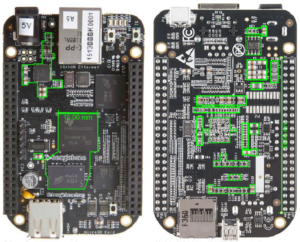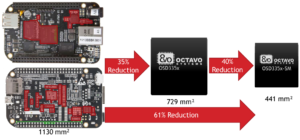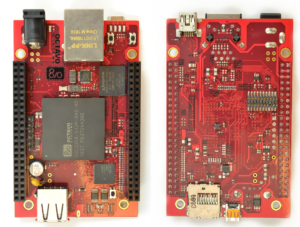
Neeraj Dantu
Posted on August, 30, 2017
Categories
Recent Posts
- Octavo Systems Unveils the OSD32MP2 Series: Revolutionizing System Design in the Electronics Industry April 9, 2024
- Securing the Future: The Integral Role of SiP Technology in Thwarting Physical Attack Vectors in Embedded Systems March 12, 2024
- Developing Secure Embedded Systems: Best Practices and Strategies March 12, 2024
- Heterogeneous Integration (HI) and System-in-Package (SiP) Technology: A Comprehensive Overview February 20, 2024
- Understanding The Differences Between System-on-Chip (SoC), Package-on-Package (PoP), System-on-Module (SoM), and System-in-Package (SiP) January 17, 2024
Smaller and Cheaper PCBs enabled by System-In-Package Technology.
Today’s embedded designers face more challenges in terms of design complexity, cycle time and target size. System-In-Package (SiP) devices, such as the OSD335x Family, bring many advantages when designing and building an embedded system.
One significant advantage of using a SiP device is the amount of printed circuit board (PCB) space that can be saved versus using hundreds of discrete components. To understand this advantage, let us examine the amount of space required by the OSD335x devices and the discrete components that make up an equivalent system. We will use the very popular BeagleBone® Black open-source development board as our baseline. The BeagleBone® Black has all the discrete components that are integrated into the OSD335x devices, including the Texas Instruments Sitara™ AM3358 ARM® Cortex®-A8 processor, DDR3 memory, the TI TPS65217C PMIC, TL5209 LDO and many passives. Figure 1 shows the top and bottom view of the BeagleBone® Black with the highlighted components functionally equivalent to the OSD335x Family of devices.

Space Savings
From the pictures, it is clear that the OSD335x devices integrate a considerably considerable number of components from the BeagleBone® Black. How does this integration help save space? One straightforward way to quantify this space savings is to measure the component areas of BeagleBone® Black that have been integrated into the OSD335x device. Then, compare that to the size of the OSD335x device that could replace them. (Note that our analysis did not take all the routing space for these components into account, so these are conservative estimates.)

Figure 2 highlights the components that are integrated into the OSD335x devices and shows the space savings offered by the OSD335x Family. In total, the components on the BeagleBone® Black take up ~1130 mm2 of PCB space. The OSD335x occupies 729 mm2 with the OSD335x-SM taking up a meager 441mm2. Using the OSD335x-SM saves almost 690mm2 of PCB space which is about a 61% reduction in required board area. Moreover, designing with the OSD335x removes the component placing and routing that the discreet AM335x solution require.
Easier Design Rules
Besides saving area, System-In-Package devices, like OSD335x Family, can lower PCB costs by reducing the need for complex routing work and the need for strict design rules. For example, the OSD335x devices already have DDR3 memory integrated. This alone eliminates the need to route, simulate and verify 48 high speed DDR Memory signals that require highly precise routing mechanisms and impedance control and add significant costs.
The OSD335x family also utilizes a large 1.27 mm pitch BGA package that makes it possible to work with relaxed design rules. For comparison, the BeagleBone® Black needed to be designed with 4 mil (0.1mm) minimum trace width, 4 mil (0.1mm) minimum distance between traces, 8 mil (0.2mm) drill and 18 mil (0.46mm) vias. These design rules were required by the demands made by routing DDR and the BGA pitch (0.8mm) of the discrete devices. In contrast, the Octavo OSD3358 SBC reference design, shown in Figure 3, which has the same functionality as the BeagleBone® Black, was designed with 6 mil (0.15mm) minimum trace width, 6 mil (0.15mm) minimum distance between traces, 12 mil (0.30mm) drill and 18 mil (0.46mm) vias.

Using the more relaxed design rules allows you to get lower cost PCBs. In this example, the BeagleBone® Black PCB costs around $2.08 at 100K quantity. On the other hand, the PCB for the OSD3358 SBC reference design was only $1.60 at 100K quantity. That is a savings of $0.48 per board or a 23% reduction in PCB cost alone just by using a System-in-Package instead of discrete components.
Conclusion
Using System-In-Package devices instead of discrete components will lower your design and PCB cost. In the example, we showed that using an OSD335x device saves over 60% in PCB area, allowing you to get smaller PCBs. We also showed that SiP devices allow you to use relaxed PCB rules resulting in cheaper PCBs. This example showed a 23% reduction in PCB cost by just relaxing the rules. We didn’t even consider the additional savings from reducing the number of layers needed in the PCB. Adding this to the design, additional prototyping and component sourcing costs, it is clear that System-In-Package devices come out as clear winners in embedded design.
To find out more please contact us.
